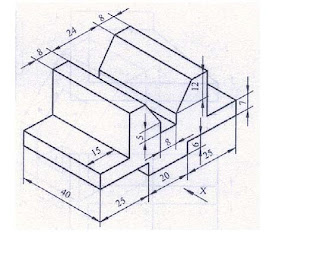B.E. Sem- 1st Regular Examination January 2011

(Common to all Branches)
Date: 23-01-2013
Time: 10:30am-1:30pm (3 hrs)
Maximum Marks: 70
Instructions:Date: 23-01-2013
Time: 10:30am-1:30pm (3 hrs)
Maximum Marks: 70
- Attempt any FIVE questions.
- Make suitable assumptions wherever necessary.
- Figures to the right indicate full marks.
- All questions are of 14 marks.
1. a) Explain the terms: (i) Eccentricity (ii) Involute (iii) Hypocycloid.
Ans: Refer article 5.8.1 page 5.6, article 6.6 page 6.5 and article 6.5 page 6.3 of ED - Basant Agrawal, TMH.
1. b) Find the locus of point P moving in a plane such that its distance from a fixed straight line AB and a fixed point remains constant.
Ans: Refer problem 5.15 page 5.15 of ED - Basant Agrawal, TMH.
1. c) Draw an ellipse by an oblong method given the major and minor axes as 120 mm and 90 mm respectively.
Ans: Refer problem 5.6 page 5.9 of ED - Basant Agrawal, TMH..
2. a) A point ‘A’ is located in the 1st quadrant. The shortest radial distance of point ’A’ from the intersection of HP and VP is 40mm and is inclined at 45º to HP. Draw projections of point.
Ans: Refer ED - Basant Agrawal, TMH second edition. 2. b) A line AB, 80 mm long, is inclined to HP by 30º and inclined to VP by 45º. The line is in first quadrant with point A 15mm above HP and 30mm in front of VP. Draw the projection of line AB.
Ans: Refer problem 9.15 page 9.15 of ED - Basant Agrawal, TMH.
2. c) Explain application of (i) Projection of Point (ii) Projection of Line.
Ans: Refer ED - Basant Agrawal, TMH.
3. a) Top View of a 75mm long line CD measures 50mm. End C is in HP and 50mm in front of VP. End D is 15mm in front of VP and it is above HP. Draw projections of CD and find angles with VP and HP.
Ans: Refer problem 9.25 page 9.29 of ED - Basant Agrawal, TMH.
3. b) A circular plate of negligible thickness having 70mm diameter is resting on HP on a point of the circumference. Plate is kept perpendicular to VP and inclined to the HP such that the plan of it is an ellipse of minor axis 40mm. Draw the projections.
Ans: Refer problem 10.23 (two stages only) page 10.24 of ED - Basant Agrawal, TMH.
3. c) Discuss application of oblique plane.
Ans: Refer ED - Basant Agrawal, TMH
Ans: Refer problem 9.25 page 9.29 of ED - Basant Agrawal, TMH.
3. b) A circular plate of negligible thickness having 70mm diameter is resting on HP on a point of the circumference. Plate is kept perpendicular to VP and inclined to the HP such that the plan of it is an ellipse of minor axis 40mm. Draw the projections.
Ans: Refer problem 10.23 (two stages only) page 10.24 of ED - Basant Agrawal, TMH.
3. c) Discuss application of oblique plane.
Ans: Refer ED - Basant Agrawal, TMH
4. a) Explain (i) Polyhedra (ii) Solid of revolution.
Ans: Refer article 11.2 page 11.1 of ED - Basant Agrawal, TMH.
4. b) A cube with a 30 mm side resting on one of its corners on the HP. Draw the projections when the base is inclined at 45º to HP and axis parallel to VP.
Ans: Refer problem 11.20 page 11.22 of ED - Basant Agrawal, TMH.
4. c) A pentagonal prism of side length of base 30 mm and height 60 mm is resting on HP with one edge of base perpendicular to VP. It is cut by a Auxiliary Inclined Plane inclined at 40º to HP and bisecting the axis. Draw sectional top view, sectional side view and true shape of the section.Ans: Refer problem 11.20 page 11.22 of ED - Basant Agrawal, TMH.
Ans: Refer problem 12.2 page 12.5 of ED - Basant Agrawal, TMH.
5. a) A hexagonal prism of 40 mm side length of base and height 80 mm is resting on HP on its base with two edges of base is parallel to HP. A square hole of side length 20mm is drilled in the prism such that all the edges of square hole are equally inclined to HP and axis of square hall bisects the axis of prism. Draw development of surfaces of prism.
Ans: Refer problem 13.29 page 13.26 of ED - Basant Agrawal, TMH
5. b) A square pyramid of side length of base is 30mm and length of
slant edge 80mm is resting on HP such that all sides of base are equally
inclined to VP. Draw the development of surface of pyramid.
Ans: Refer problem 13.9a pages 13.9 of ED - Basant Agrawal, TMH.
5. c) Explain: (i) Arc length in development of cone (ii) Application of Development of Surfaces.Ans: Refer chapter 13 of ED - Basant Agrawal, TMH.
Ans: Refer problem 13.9a pages 13.9 of ED - Basant Agrawal, TMH.
5. c) Explain: (i) Arc length in development of cone (ii) Application of Development of Surfaces.Ans: Refer chapter 13 of ED - Basant Agrawal, TMH.
6. a) Draw orthographic view (i) elevation (ii) top view (iii) left hand side view of the following figure 1,Use 1st angle projection system.
6. b) Explain types of Projection with application.
Ans: Refer chapter 7 of ED - Basant Agrawal, TMH.
7. a) Draw the Isometric view of the following figure 2.
 |
| Fig. 2 |
Ans: Refer problems 15.12 pages 15.12 of ED - Basant Agrawal, TMH.
Overall: This is the simplest question paper ever released by GTU.


